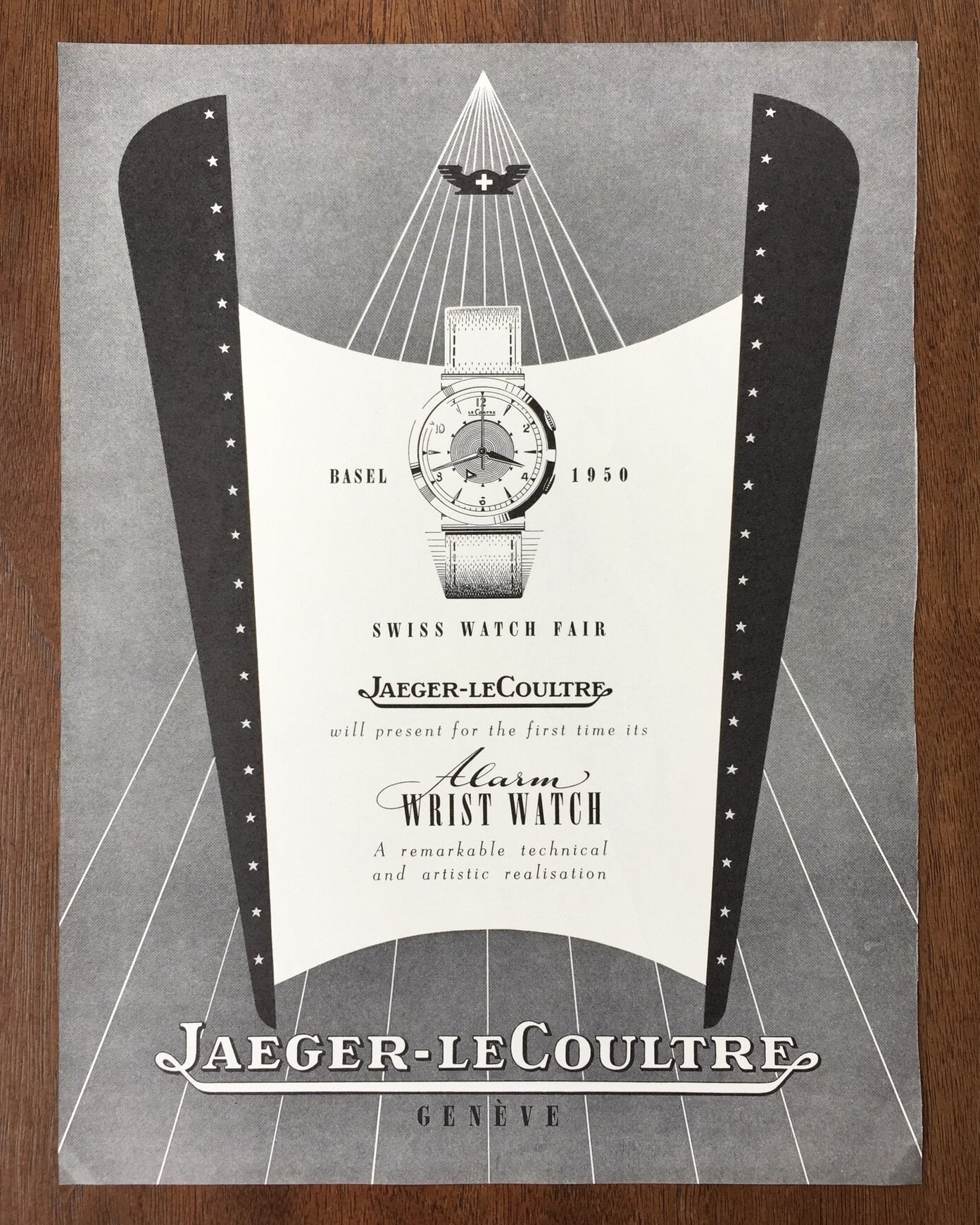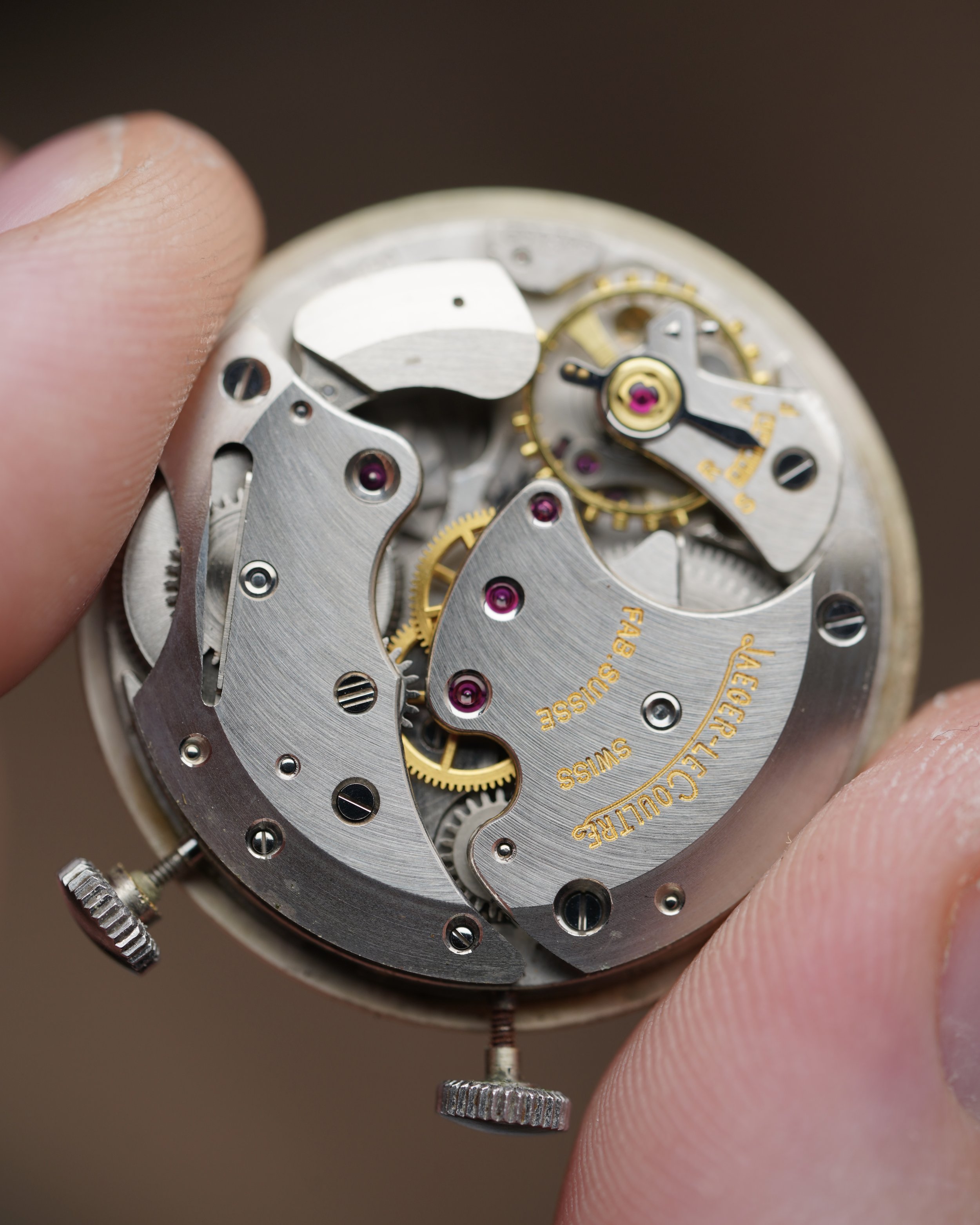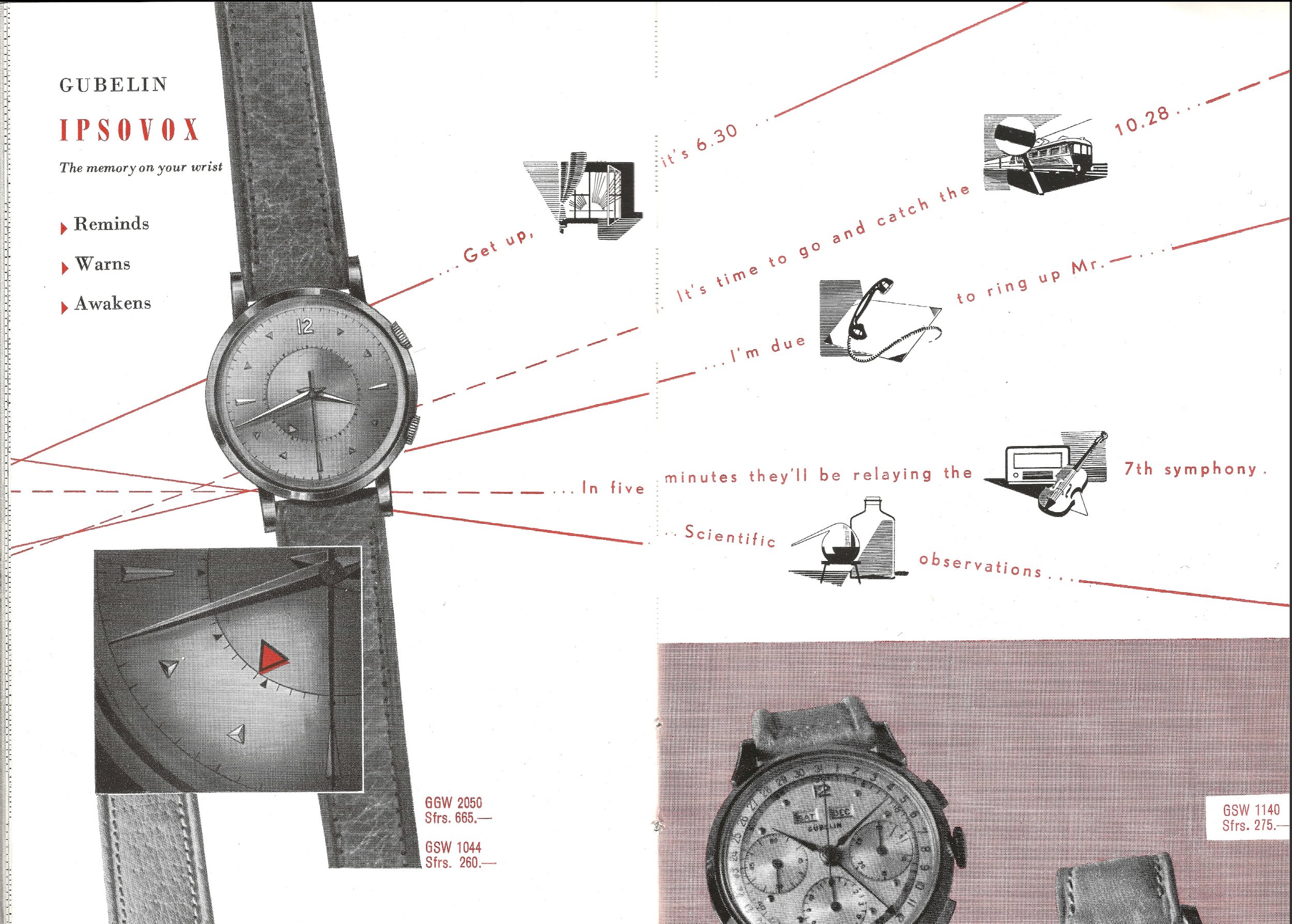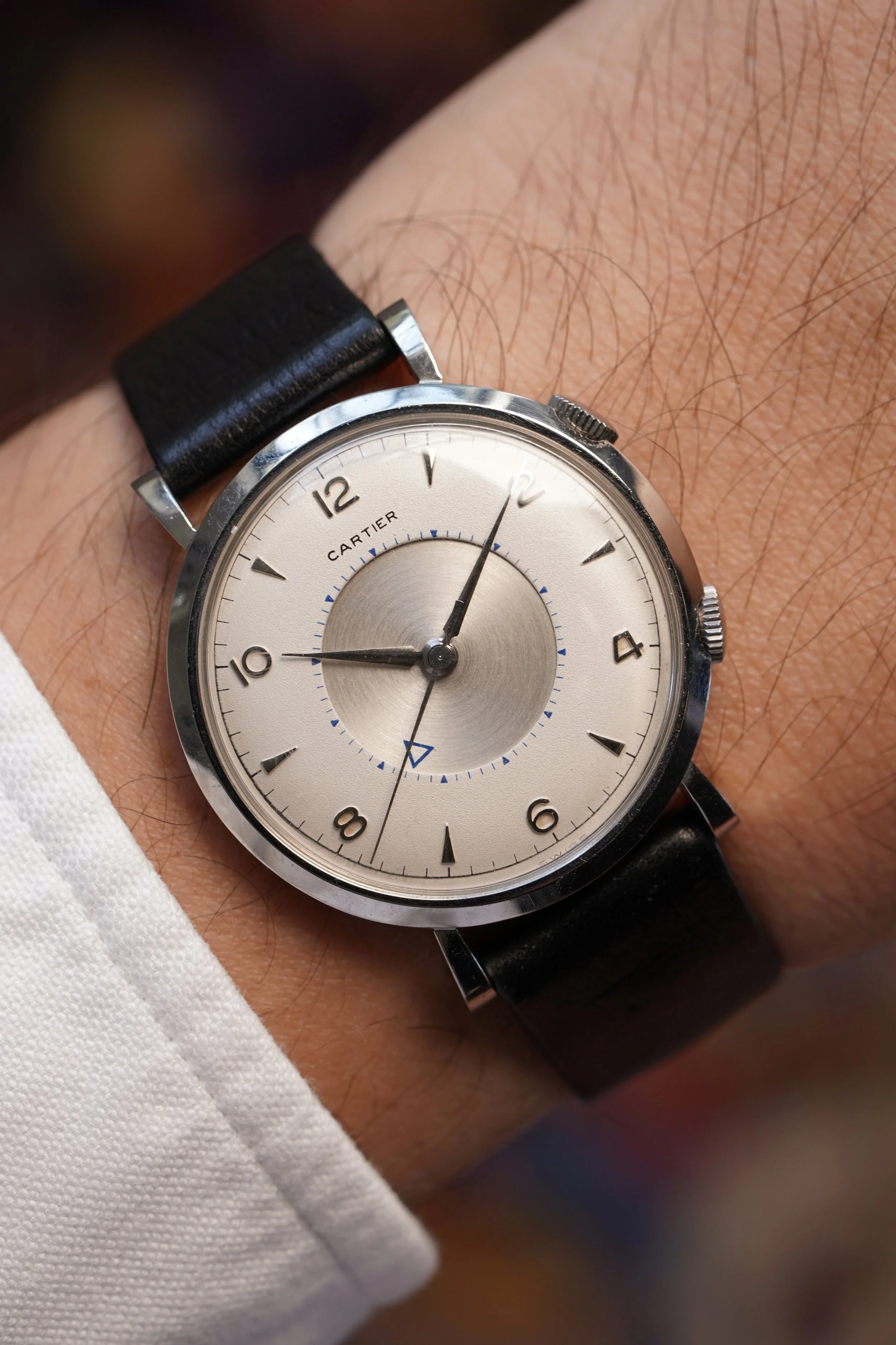Collector’s Guide: The Jaeger-LeCoultre Memovox Reference 3151
I was recently a guest on Collectors Gene Radio and during our conversation, Cameron Ross Steiner mentioned he was interested in reading future articles on the Wind Vintage Blog about the watches in my personal collection. While I wrote a few weeks back on the Rolex GMT-Master Reference 1675, the article was a collector’s guide focused on dozens of 1675s sold at Wind Vintage (my personal reference 1675 being just one example). For this article, I will highlight my latest acquisition and what to look for in the model. If you know me at all, it is no surprise that the watch is a vintage Jaeger-LeCoultre, specifically the Memovox reference 3151.
The Memovox is a special watch to me. My first vintage watch was a reference E 855, and I’m determined to have everyone associate it with me (as they do with that one guy’s Mk40 Speedmaster). Alarm watches were very much the complication to have throughout the 1950s and 1960s. They were the practical complication that “reminds, warns, or awakens” and is “an invaluable memory aid. From the instant, its buzz ushers in a new day, until it gently reminds its owner of the day's last appointment.” I absolutely love the look of a dual-crown watch, and the rotating central disc is a great feature to show someone who has no concept of the mechanical alarm wristwatch. To this day, they remain one of the most undervalued complication. While Vulcain’s Cricket was the first mass-produced alarm wristwatch introduced in 1949, Jaeger-LeCoultre was developing their complicated timepiece during the Cricket’s release.
Image credit: Jaeger-LeCoultre
Image credit: Jaeger-LeCoultre
American market Jaeger-LeCoultre catalog from the 1970s.
Introduced in 1950 at the Basel Fair, Jaeger-LeCoultre’s alarm wristwatch was one of the most significant releases within the watch industry. The later defined “Memovox” would take on several adaptations in the form of and entire product line of pocket watches, as well as stationary and travel clocks. While perhaps not spoken about as frequently as other models, there is no doubt that the Memovox is an icon.
Speaking with prominent JLC expert/collector @fldx_clavi, he emphasized a poignant observation that seems to go unspoken. “Amongst Jaeger-LeCoultre, the Memovox is the watch with the longest, uninterrupted production. The Memovox has been present in one form or another in every catalog since its introduction in 1950. That’s 73 years of continuous production!” Clavi would go on to point out that even outside of Jaeger-LeCoultre’s catalog the model has had an extreme run. “The Memovox has been in production longer than models such as the Rolex Submariner (introduced in 1954) as well as the OMEGA Speedmaster (introduced in 1957)!”
1950 Basel Fair ad of Jaeger-LeCoultre reference 3150 Memovox with hooded lugs powered by the calibre 489. Image credit: Ad Patina
Jaeger-LeCoultre Product & Heritage Director Matthieu Sauret would share his insights on this Memovox model. “The 3151 is superlative historical reference of Jaeger-LeCoultre. It is one of the two Memovox models to be released in 1950 which marks the legacy of our manufacture and its long standing (and uninterrupted) commitment to the alarm complications.”
Eric Wind would add on to the subject “I find the early Memovox watches from the 1950s to be extremely charming, rare to find in unpolished condition with original dials, and some of my favorite alarm watches to wear. I think people are sleeping on these, partially because they so rarely come to market in good condition. The cases are spectacular with interesting and crisp angles, as are the beautiful dials with gorgeous hour markers. I try to get any great ones I see out there in the market!”
Journal Suisse d'Horlogerie | 1951
The Dial
I can’t recall whether this particular watch was found by Eric Wind, or whether I pointed it out to him. I had been absolutely swamped with emails over the past few weeks, so when this came in, I barely recalled we had purchased it. Regardless of which one of us is worthy of praise, we were extremely pleased to see the dial was in good shape upon arrival!
Yes, there were some stains on the exterior and smudges, but this is vintage watches! Besides, they were not too jarring. The surrounding area of the dial is bound to be compromised on most of these models due to the snap-on case.
Luckily, much of the dust/marks on the dial were able to be removed with the help of our watchmaker, Jose (nicknamed by Eric as “El Mago” or “The Magician”). The crystal had some scuffs and after a polish we were pumped at the stunning appearance.
“¿Puedes apagar el dial por favor?”
“Sí” replied Jose.
“Gracias! ¿Puedes pulir el cristal también?”
“Sí, Charlie,”
“Gracias, Jose!”
It is not often that you get to find nice 1950s Jaeger-LeCoultre models, particularly with non-luminous dials. Both the hands and hour markers are made of rose gold. Although several manufacturers would incorporate stainless steel cases and rose-gold dial furniture, I always appreciate the way vintage Jaeger-LeCoultre timepieces look with this combination.
One thing with that is tricky about this two-tone look is that you have to have a specific color for the strap to make it look great. I paired it with our Wind Vintage brown featuring a white stitching for contrast. I personally think these 1950s models need a strap with contrasting stitch or at least has an aesthetic for the era. For 1960s models, the options become a bit more wide. This is one of my personal favorite straps, and it is made by the legendary-leather goods specialist Nick Gabarro.
The 3151 has a number of dial variants. These include dauphine/arrow-head markers, two styles of even-Arabic numerals (both luminous and non-luminous styles) with alpha hands and dauphine hands, luminous-Arabic numerals with luminous “kite” hands, and an early variant with the Arabic 12 with pyramid and arrow-head markers which can be seen in the catalog excerpt within this article. There is also a variant with luminous plots on the interior of the fixed dialThis particular example features the blue minute demarcations and alarm triangle. This touch of color is very attractive and often not seen in dials from the period - with exception to some chronograph models from the likes of Movado.
The Case
The 3151 enters into the equation at a time of when we see more conservative case designs from JLC, and it stands out for having a touch of flamboyance! The case measures 35mm in diameter and is quire long with a length of 42mm lug-to-lug. The lugs flair out and have a lug width of approximately 18mm. It is a two-body case design, with the lugs attached to the bezel and the case back being a snap on. The crowns are unsigned on these models.
The bezel has a nice angled shape, which is attractive to look at from the wrist. While the stainless steel cases are not indicated with hallmarks, gold examples are found with the Poinçon de Maître #3 key. This case maker appears to be unknown, and I have been anxious to learn the maker’s name for years. It is most often seen in cases for Jaeger-LeCoultre. My hypothesis is that the case maker had a relationship similar to that of Rolex and Genex, and possibly worked exclusively with Jaeger-LeCoultre. Any information or insights would be greatly appreciated!
Comparison of the Memovox reference 3151 to the later Memovox reference E 855.
Comparable to the highly-collectible 37mm reference E 855, it actually wears very well due to the length of the case. On the wrist, I am often surprised at how well it wears! Eric said he thought it looked like a great watch for my collection, and I was quite overwhelmed when he gifted it to me! Not a bad perk of the job!
Clavi would illuminate the origin of this lug design. “The 3151 has a fairly specific lugs design, which we could [categorize] as “2D drop lugs” or “Flat drops”. We can trace the precursors of the design of both the 3151 and the 3150 lugs in the march 1950 catalog, as these 2 boy-size watches share a striking resemblance to their ringing counterparts!” These lugs are fairly delicate and should be handled with a bit of mindfulness when disassembling or wearing. “The style was abandoned in the later evolutions of the Memovox in favor of stronger lugs. Unfortunately, I have seen a few handicapped 3151 suffering from one or even two amputated lugs!”
1950 Jaeger-LeCoultre catalog courtesy of @fldx_clavi
Calibre P489
The Memovox reference 3151 is powered by the calibre P489/1, which is also highlighted in the above Basel Fair advertisements (featuring another of the pioneer reference 3150). The calibre 489 is in fact the origin story of Jaeger-LeCoultre’s alarm wristwatch. It debuted in 1950 and would remain in production until circa 1958. According to The Collectibles, this calibre would be the sole alarm calibre for JLC’s wristwatches for the first two years when the short lived and much rarer calibre 601 was introduced. JLC would seize production of the 601 during the same year of 1952. The manufacturer cites approximately 47,500 calibre 489 movements were produced throughout the eight-year run.
Image credit: WatchGuyUK
Image credit: WatchGuyUK
Image credit: WatchGuyUK
The movement is a 17-jewel calibre which operates at 18,000 vibrations per hour. This particular example is designated with the P489, indicating it has Parachoc shock protection. They were a provider of shock-protection to the majority of the manufacturers in the industry. Interestingly, Parechoc S.A. was also based in Le Sentier. It is now known as Kif Parechoc.
Parechoc S.A. LeSentier advertisement. Image Credit: Europa Star: (TRADE BULLETIN | 1950 | ISSUE #197 | 1/13 | PAGE 8)
Advertisements & Catalogs
The Collectibles cites these models were produced from 1950 to 1956. Interestingly, the case reference 3151 is slightly different in what appears to be some of the earliest examples, These feature more straight lugs, instead of the more common flared style. In the below 1951 advertisement of Journal Suisse d'Horlogerie and the advertisement these can be seen. In the Journal Suisse d'Horlogerie advertisement, the lugs are straight, rather than flared.
Gübelin catalog featuring the JLC Ipsovox. Source: Daniel Benyamin
Journal Suisse d'Horlogerie | 1951
Image credit: Artcurial
While my understanding of the Memovox was that the line began with the reference 3150, @fldx_clavi shared his insights on the subject I found extremely interesting.
“Although the 3150 ‘hooded lugs’ is often presented as the first Memovox - as it was the prototype presented at Basel, and the reference 3150 is 1 digit before 3151 - actually both 3150 and 3151 should equally considered the first Memovoxes to be introduced commercially. The 3150 was actually very short-lived. They appear both together in the general catalog dated Novembre 1951 (AKA ‘the 1952 catalog’ provided below in your article by Jaeger-LeCoultre), from the next iteration of this catalog only the 3151 remains. There is even a previous catalog, dated April 1951, in which the 3150 is already removed, and the 3151 is the one and only Memovox to get the spotlights (and also the first watch shown in the catalog, rightfully so, page 2)!”
1951 Jaeger-LeCoultre catalog courtesy of @ldx_clavi
“So we can assume that the Memovox was introduced to the world from the beginning with 2 choices of cases, as it is likely the ‘hooded lugs’ was deemed innovative and a bold choice, so they went safe by offering a more conservative approach with the 3151 as well. It seems that the market proved that this choice was too bold and it was promptly abandoned.
Another reason might have been that the 3150 had a major design flaw : the hooded lugs are integral to the bottom and side parts of the case / caseback, and the top (bezel and glass) is only clipped to this ensemble, and unlike normal watches (and 3151), not firmly held in place on the wrist together with the strap. The watch can easily pop open, sending basically all the internals (movement / dial / hands ) in outer space in the process!”
Neue Zürcher Zeitung, Number 2822, 12 December 1952
Türler advertisement from circa 1952. Image credit: hifi
Neue Zürcher Zeitung, Number 2753, 6 December 1952
Neue Zürcher Zeitung, Number 2674, 29 November 1952
A similar model for the American market
Neue Zürcher Zeitung, Number 2874, 19 December 1951 Edition 03
Montres Horlogerie de Luxe Genéve Jaeger-LeCoultre catalog from 1952. Image courtesy of Jaeger-LeCoultre Heritage Department.
“For men's watches - chronographs for 6 percent - leather is king, edged with pronounced stitching. A manufacturer added a compass to the bracelet, imitating a colleague who had placed the same object on the dial. Last year, an alarm watch — the Mémovox — from a Geneva company was featured at the Fair. The Cricket, manufactured in La Chaux-de-Fonds, was present this year, due to the lack of a display window available in 1950. It also enlarged its format. A third alarm watch joined the ranks: the Lanco-fon from a factory in Langendorf. It does not use a resonance membrane. Its handling is very simplified.”
L'impartial, 21 April 1951
Catalog courtesy of @fldx_clavi
Within a vintage Jaeger-LeCoultre Memovox catalog dating to circa 1958, the non-luminous reference 3151 is cited as being produced in steel or gold. It can be seen amongst the reference 3155 described as having “80 micron yellow gold plating, [and an] embossed dial”, as well the reference 3156 featuring a “yellow or red gold-plated case and embossed dial”.
Neue Zürcher Zeitung, Number 2405, 3 November 1951
Der Bund, Volume 103, Number 561, 30 November 1952
A similar style for the French market. image credit: WatchProSite
Image credit: OMEGAForums
Der Bund, Volume 104, Number 496, 24 October 1953
Neue Zürcher Zeitung, Number 3128, 18 December 1953 Edition 03
Der Bund, Volume 106, Number 584, 14 December 1955
Comparable Examples
Every now and then, I come across these early models. As mentioned before, the main differentiation is within the dial variants. It is not uncommon for these to be reprinted or heavily compromised due to the non-hermetically sealed case. Below you can see several of the variations made throughout the 1950s.
Image credit: @fldx_clavi
Image credita: ricardo.ch
Image credit: Sotheby’s
Image credit: Sotheby’s
Image credit: Sotheby’s
Image credit: Sotheby’s
American market LeCoultre [Memovox] Wrist Alarm with a gold-filled case made by Wadsworth. The style is similar to the reference 3155.
Image credit: @fldx_clavi
Image credit: @fldx_clavi
When it comes to 3151s which achieve the highest premiums, the Cartier examples are undoubtedly the most expensive. Below are also several known examples retailed by Cartier. Two of these are also owned by @fldx_clavi. Among the other two are examples sold by Eric Wind to great collectors - both of whom were generous enough to allow me time to admire their incredible examples!
Image credit: DeMessy
Image credit: @fldx_clavi
Image credit: @jaeger59
Image credit: @cartierarchivist
Image credit: vintage-watches-collection.com
Speaking with @fldx_clavi on retailer variants, he would also mention examples by Gübelin IpsoVox. While I don't recall any specific examples off the top of my head, I would not be surprised if there are examples retailed by Türler based on the very close relationship between to two companies during this period, as well as the frequent advertisements.
Image credit: @tempvsfvgitnyc
“The reference was also the gift chosen by Swiss authorities to Charlie Chaplin which marked history” Sauret would point out. This particular example dates to 1953 and is certainly one of the most prominent examples. The watch was given to Chaplin by the Government of Vaud upon the family’s decision to relocate to Switzerland. While it would seem the watch currently resides in the Chaplin estate, I was informed this is not the case upon inquiry. I personally would not be surprised if this example was among the most valuable vintage Memovox watches solely due to the provenance.
“The Vaud Council of State received yesterday afternoon, at the Château de Lausanne, in strict privacy, Charlie Chaplin, who has been established in the canton since December 1952. This reception was followed by a walk in the vineyard of Lavaux, then a candlelit dinner at the Château de Glérolles. After this dinner, the Vaud government presented Ms. Chaplin with a scarf with designs evoking the vineyard and the grape harvest, Ramuz's book on the Pays de Vaud and a basket of flowers.
After the afternoon reception, kind words were exchanged between Mr. Despands, State Councilor, and the author of "Limelight", to whom a gold watch was presented as a token of gratitude and of admiration.”
- La Suisse libérale, Number 233, 7 October 1953
La Suisse libérale, Number 233, 7 October 1953
Closing Thoughts
In closing, I find the reference 3151 to be a very elegant and stylish model. Of the initial Memovox models, I believe the 3151 is one of the more enjoyable references to feature a non-waterproof case. While the reference 3150 with tubular or hooded lugs is very interesting and design focused, I would prefer a model with more real estate on the wrist, which the 3151 achieves. Is the watch as wearable as the reference E 855 or the reference E 875? I would lean towards saying “No” based on the fact I live in Florida, and it is a much more humid environment for casually wearing dress watches. This is also true for my beloved reference 2983. The etanche (water resistant) references are just a bit more comfortable going in and out of air-conditioned buildings or vehicles. That is not to say I am overly concerned about wearing this watch. I find the daily wear of a Rolex Oyster to be unconcerning. Nevertheless, I will certainly be wearing this watch on special occasions or during decent weather. On a more favorable side to the etanche models, I really find non-luminous timepieces from the 50s to be incredible watches. This dial is extremely attractive, and I am obsessed with admiring it. Despite the watch currently needing a service, the alarm is super loud! I cannot wait to get this thing up and running!
Acknowledgements
A very special thanks to Eric Wind for the generous gift. I love this one and am curious if you were aware of the “Charlie” provenance! A very special thanks to @fldx_clavi for the outstanding insights. You are always elevating my excitement for these write ups! A very special thanks to Cameron Ross Steiner for requesting more articles. I knocked this one out on a Sunday afternoon after your motivating commentary! A very special thanks to Jaeger-LeCoultre for the incredible publication ‘The Collectibles’. Special thanks to Product & Heritage Director Matthieu Sauret for generously sharing primary source material and information on JLC timepieces. Special thanks to Andrea Persson Truppel of JLC. A very special thanks to Giuseppe Sciascia for always helping us learn more about these beautiful timepieces! Special thanks to my father, Chris. Did you learn something new? A special thanks to my friend Steve. Sorry I missed our collector’s dinner! Special thanks to vintage Jaeger-LeCoultre collectors for the support and interest.

























































































